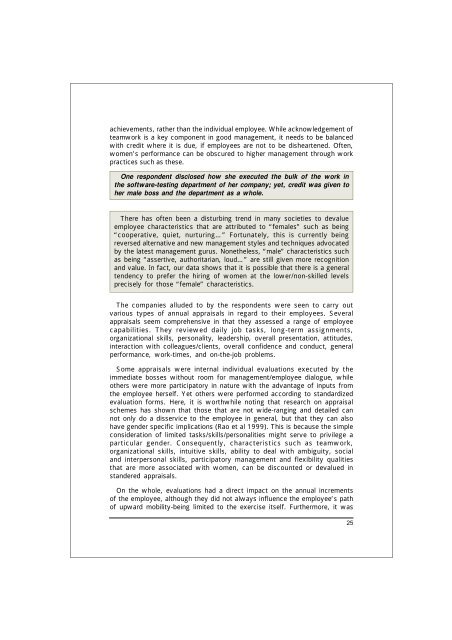Beyond Glass Ceilings and Brick Walls - International Labour ...
Beyond Glass Ceilings and Brick Walls - International Labour ...
Beyond Glass Ceilings and Brick Walls - International Labour ...
You also want an ePaper? Increase the reach of your titles
YUMPU automatically turns print PDFs into web optimized ePapers that Google loves.
achievements, rather than the individual employee. While acknowledgement of<br />
teamwork is a key component in good management, it needs to be balanced<br />
with credit where it is due, if employees are not to be disheartened. Often,<br />
women’s performance can be obscured to higher management through work<br />
practices such as these.<br />
One respondent disclosed how she executed the bulk of the work in<br />
the software-testing department of her company; yet, credit was given to<br />
her male boss <strong>and</strong> the department as a whole.<br />
There has often been a disturbing trend in many societies to devalue<br />
employee characteristics that are attributed to “females” such as being<br />
“cooperative, quiet, nurturing…” Fortunately, this is currently being<br />
reversed alternative <strong>and</strong> new management styles <strong>and</strong> techniques advocated<br />
by the latest management gurus. Nonetheless, “male” characteristics such<br />
as being “assertive, authoritarian, loud…” are still given more recognition<br />
<strong>and</strong> value. In fact, our data shows that it is possible that there is a general<br />
tendency to prefer the hiring of women at the lower/non-skilled levels<br />
precisely for those “female” characteristics.<br />
The companies alluded to by the respondents were seen to carry out<br />
various types of annual appraisals in regard to their employees. Several<br />
appraisals seem comprehensive in that they assessed a range of employee<br />
capabilities. They reviewed daily job tasks, long-term assignments,<br />
organizational skills, personality, leadership, overall presentation, attitudes,<br />
interaction with colleagues/clients, overall confidence <strong>and</strong> conduct, general<br />
performance, work-times, <strong>and</strong> on-the-job problems.<br />
Some appraisals were internal individual evaluations executed by the<br />
immediate bosses without room for management/employee dialogue, while<br />
others were more participatory in nature with the advantage of inputs from<br />
the employee herself. Yet others were performed according to st<strong>and</strong>ardized<br />
evaluation forms. Here, it is worthwhile noting that research on appraisal<br />
schemes has shown that those that are not wide-ranging <strong>and</strong> detailed can<br />
not only do a disservice to the employee in general, but that they can also<br />
have gender specific implications (Rao et al 1999). This is because the simple<br />
consideration of limited tasks/skills/personalities might serve to privilege a<br />
particular gender. Consequently, characteristics such as teamwork,<br />
organizational skills, intuitive skills, ability to deal with ambiguity, social<br />
<strong>and</strong> interpersonal skills, participatory management <strong>and</strong> flexibility qualities<br />
that are more associated with women, can be discounted or devalued in<br />
st<strong>and</strong>ered appraisals.<br />
On the whole, evaluations had a direct impact on the annual increments<br />
of the employee, although they did not always influence the employee’s path<br />
of upward mobility-being limited to the exercise itself. Furthermore, it was<br />
25
















